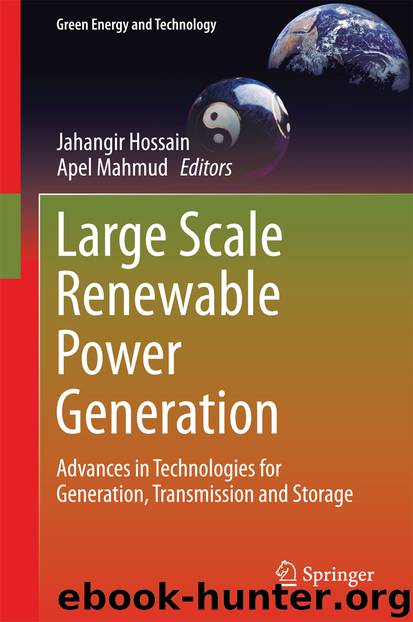Large Scale Renewable Power Generation by Jahangir Hossain & Apel Mahmud

Author:Jahangir Hossain & Apel Mahmud
Language: eng
Format: epub
Publisher: Springer Singapore, Singapore
6 Enabling the HVDC System to Deliver Frequency Response
There are several challenges that de future power systems will face in coming future. One of them is meets rising energy requirements in a manner that is sustainable, secure, and competitive. There is no single answer for this situation; however, there are several aspects to consider regarding primary resource [47, 48]: (i) greater energy efficiency and conservation, (ii) increased use of resources that are secure, indigenous, sustainable, clean, and competitive.
A potentially realistic solution for this situation is the use of a primary energy source, which is a clean, and fuel cost-free, wind power. This resource is enormous in the Europe’s offshore and the amount available is able to meet Europe’s demand seven times over. There are 150 GW on offshore wind projects are already at various stages of planning and development. The North Sea has a vast potential for renewable energy generation: offshore wind power, tidal and wave energy.
High Voltage Direct Current (HVDC) systems are more flexible than their AC counterparts and it offers distinct advantages for the integrating offshore wind farms to inland grid system. The Voltage Source Converter (VSC) HVDC transmission system enable fast and flexible control active and reactive power, and can alleviate the propagation of voltage and frequency deviations due to wind variations in wind strength. It seems advances on technologies open the door for VSC HVDC systems at higher voltage and higher power range, which is making multi-terminal HVDC (MTDC) system a technical possibility [47].
Wind power evolution in Northern Europe is foreseen to continue in the future with development of large-scale wind power on far offshore. Integration scheme of these wind farms to the onshore grids would grow from point-to-point connection to a transnational multiterminal network where the transmission capacity serves both to evacuate the wind power and to facilitate power trading between countries.
Supergrid will be the transmission backbone of Europe’s decarbonized power sector. It will facilitate the trading of electricity across and it will strengthen security of supply [49].
Although the Supergrid has gotten much attention, it cannot be built yet. Many Supergrid topologies have been proposed or studied by different organizations [50–52]. Regulatory and policies aspects have been defined: A single planner (European Network of Transmission System Operators for Electricity, Entso-e), a single operator (ISO), a single grid code (Entso-e), and a single European regulator (ACER). However, North Sea Supergrid can probably not be built as a planned and optimally structure [48].
The main reason, independently planned projects would be coupled together, leading to a rather grown network, comprising several DC and AC voltage levels and maybe different frequencies. The 2030 Possible optimized integrated offshore network development based on results of Entso-e is depicted on Fig. 21. It is based on the national target in terms of offshore wind power for North Sea national, scenario 2030, it was created by European Wind Energy Association (EWEA), and depicted in Fig. 22. Large offshore DC links in excess of several gigawatt may have several capabilities to enhance the grid stability [53].
Download
This site does not store any files on its server. We only index and link to content provided by other sites. Please contact the content providers to delete copyright contents if any and email us, we'll remove relevant links or contents immediately.
Life 3.0: Being Human in the Age of Artificial Intelligence by Tegmark Max(5474)
The Sports Rules Book by Human Kinetics(4288)
The Age of Surveillance Capitalism by Shoshana Zuboff(4207)
ACT Math For Dummies by Zegarelli Mark(3982)
Unlabel: Selling You Without Selling Out by Marc Ecko(3587)
Blood, Sweat, and Pixels by Jason Schreier(3564)
Hidden Persuasion: 33 psychological influence techniques in advertising by Marc Andrews & Matthijs van Leeuwen & Rick van Baaren(3472)
The Pixar Touch by David A. Price(3362)
Bad Pharma by Ben Goldacre(3352)
Urban Outlaw by Magnus Walker(3338)
Project Animal Farm: An Accidental Journey into the Secret World of Farming and the Truth About Our Food by Sonia Faruqi(3175)
Kitchen confidential by Anthony Bourdain(3006)
Brotopia by Emily Chang(3000)
Slugfest by Reed Tucker(2937)
The Content Trap by Bharat Anand(2860)
The Airbnb Story by Leigh Gallagher(2797)
Coffee for One by KJ Fallon(2559)
Smuggler's Cove: Exotic Cocktails, Rum, and the Cult of Tiki by Martin Cate & Rebecca Cate(2469)
Beer is proof God loves us by Charles W. Bamforth(2370)
